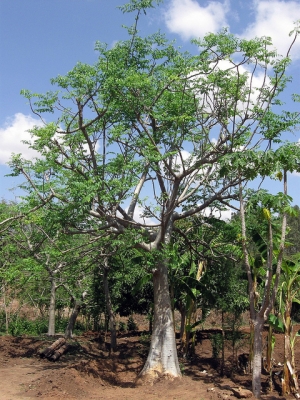BigTreeSupply.com: Proper Tree Nutrition

Trees need nutrients - chemical elements and compounds - for their internal metabolism and growth. Without the right amount of nutrients, a tree will have difficulty maturing. It will also become weak and more susceptible to disease. Symptoms of poor nutrition include dieback, deformed leaves, bark disorders and withered blossoms, as well as slow or no growth.
Trees get some of their nutrients from the air, including oxygen, hydrogen and carbon. These are called non-mineral nutrients. Through the process of photosynthesis, trees use energy from the sun to convert carbon dioxide (carbon + oxygen) and water (hydrogen + oxygen) into starches and sugars – the tree’s food.
Mineral nutrients, which come from the soil, make up the rest of a tree’s food. There are two types of mineral nutrients, macronutrients and micronutrients.
Macronutrients refer to nutrients that are needed in large quantities. There are two types of macronutrients, primary and secondary.
Primary macronutrients include nitrogen, phosphorus and potassium.
There are many factors that determine the amount of nitrogen in the soil, including temperature, moisture and soil conditions. When nitrogen is lacking, the photosynthesis process speeds up and turns leaves yellow. A nitrogen deficiency can also result in stunted growth, small leaves and leaf drop.
Phosphorus converts light energy to chemical energy. Phosphorus deficiencies typically occur in regions with extensive rainfall. Indicators of a phosphorus deficiency include slow growth and leaves that turn dark green or blue/green. Inadequate phosphorus also leads to necrosis – cells that die prematurely.
Trees need potassium for various internal processes. Insufficient potassium can make trees more susceptible to disease and damage during hot or cold weather. Potassium deficiency often occurs in soil that is sandy.
Soils can have an insufficient amount of macronutrients because they are used in such high volume by plants.
Calcium, magnesium and sulfur are the secondary macronutrients (nitrogen, phosphorus and potassium are the primary ones). Other types of nutrients include iron, chlorine, manganese, nickel, zinc, boron, copper and molybdenum.
The leaves of trees that don’t have enough iron will turn yellow. A tree that has a manganese deficiency will have yellow leaves with green bands near the veins. When a big tree has inadequate zinc, various types of stunted growth can occur. The tree’s leaves will also turn yellow.
Each of these elements play an important role in the growth and health of the tree. If any of these nutrients are missing, the tree can end up dying. Especially if moving trees is to be done, it is important for the transplanted tree to be given proper nutrients.
At the same time, there are also many variables involved in tree nutrition. For example, different species of trees can have their own unique nutrient requirements. Too much of a certain type of nutrient in one tree can cause toxicity, while the same amount in another can be a deficiency.
There are also times when a tree may look like it has a nutrient deficiency, but the problem is actually being caused by something else, such as too much or too little watering, soils that don’t drain well, pests or diseases.
There are various ways to test for nutrient deficiencies, including soil and leaf analysis. If you have a tree with yellow leaves or other signs of a nutrition deficiency, consult a big trees specialist. Professional tree suppliers can give you good advice on how to properly care for your trees.
